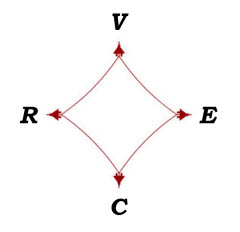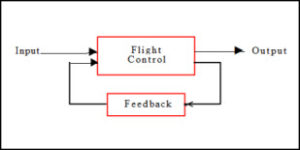Ready Room:
Assessing the Leadership Diamond©

As a subscriber to Aviation.Org’s website titled Cockpit Leadership, you have been introduced to the Leadership Diamond©, its founding principles and its specific application to the flight environment.
The diamond is described as a mental model wherein its strategic outward leadership forces (vision, courage, reality, ethics) are applied in equal measure to ensure the issue at hand is being fully considered.
The pilot’s strategic thinking utilizing the diamond is not in conflict with any accepted rules or procedure. To the contrary, the diamond encourages thorough evaluation of any event or situation encountered.
Pilot Maxims
Throughout this Cockpit Leadership presentation, pilots offer their opinions on the skills and attributes they value in other pilots. These comments are from varied sources such as surveys, reports and articles.
These are pilots talking—in their own words—about the pilots they respect. Their quotations give added strength to the diamond’s underpinning since their comments, strategically grouped, receive equal emphasis.
To illustrate, pilot quotes from a magazine series are summarized in diamond format in the Recap section below.
Critique
This Ready Room topic seeks to stimulate pilot-to-pilot discussion on the diamond’s approach to strategic thinking. For example,
Does this disciplined approach resonate with you?
Would you visualize the diamond as you analyze an issue at hand? Or, more simply,
Would you consider the diamond as a four point checklist that gives equal consideration and weight to its cardinal forces?
All comments are welcomed, supportive or otherwise. Any related experiences will add breadth to the discussion.
Recap: Pilot Quotes in Diamond Format
These quote are pilots’ answers to the question posed by Professional Pilot magazine, “What skills and attributes do good pilots share?” The answers are summarized in diamond format as follows:
Vision
Anticipation. The best pilots anticipate and think ahead. They stay “miles ahead of the aircraft,” and maintain the “big picture.” They exhibit “common sense” (exceptional judgment), thereby keeping out of bad situations. They play out multiple scenarios, consider available options and select the best course of action. They maintain situation awareness. The best are skilled at communication and, importantly, articulate their intentions. They are optimistic and maintain a positive attitude. Above all, they have a passion for flying and love what they do.
Courage
Confidence (and their confidence isn’t mistaken for arrogance). The best pilots check their egos “at the door.” They have the ability to handle situations with comfort and presence. They are at ease and are calm while analyzing complex situations and making decisions. They don’t jump to conclusions. Their decisions “maximize benefits and minimize risks.” They know when to say “no.” Above all, the best have the ability and self-confidence, in either seat, to admit mistakes instead of making excuses. In fact, they are comfortable with critical feedback.
Reality
Knowledge. The best pilots have a “thirst for knowledge,” seek to increase their grasp of aviation, and have an aptitude for learning new systems and techniques. They listen. They are teachable and learn from their mistakes. They sharpen their skills to limit complacency, and critique themselves. The best are humble, know their personal limitations and are unwilling to exceed them. They make a conscious commitment to safety, and review “the first few minutes of flight before it leaves the ground.” They are prepared, pay attention to detail and analyze what’s going on. And, as stated above, they maintain awareness of the reality of their situations.
Ethics
Integrity. The best pilots have integrity and do what they say they will do. Honesty is a prime attribute. These pilots are professionals and pursue the highest standards. They possess strong people skills; they create a pleasant cockpit atmosphere, are personable, diplomatic and have an approachable nature. The best treat others as they would be treated; they respect other pilots, ATC and service personnel and don’t talk negatively about others. These pilots are team players and foster teamwork. They want to give back “what was received starting out,” and pass along knowledge and techniques in a “non-condescending manner.” They share experiences and strive to “hangar talk.” Good customer service and relations are important to these professionals. model


2 thoughts on “Assessing the Leadership Diamond©”
Very helpful!
Interesting…
Thank you